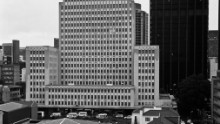
Photos: Johannesburg: City of skyscrapers
Trail blazer – The
60-meter Eskom Centre was the tallest skyscraper in the city when it
was completed in 1955 as the headquarters of the Electricity Supply
Commission.
The building still stands today but the company moved out over 20 years ago, declaring it inadequate for modern business needs.
The building still stands today but the company moved out over 20 years ago, declaring it inadequate for modern business needs.
Hide Caption
10 of 18

Photos: Johannesburg: City of skyscrapers
Falling down – The
Hillpoint Highbrow was one of the most ambitious developments, standing
over 100-meters tall, and providing stylish accommodation for the city
elite on top of a popular cinema.
The towers later fell into dilapidation as the surrounding area declined, and continues to suffer with high rates of crime and poverty.
The towers later fell into dilapidation as the surrounding area declined, and continues to suffer with high rates of crime and poverty.
Hide Caption
11 of 18
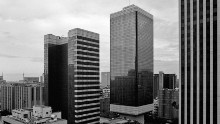
Photos: Johannesburg: City of skyscrapers
Sunset – The
twin towers of the Johannesburg Sun Hotel sustained a five-star rating
from their opening in 1970 until the 1990s, when it was downgraded due
to high crime rates in the surrounding downtown area.
The hotel closed its doors in 1998, and after several failed attempts at reopening, stands empty today.
The hotel closed its doors in 1998, and after several failed attempts at reopening, stands empty today.
Hide Caption
12 of 18
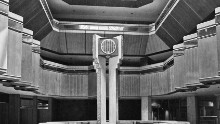
Photos: Johannesburg: City of skyscrapers
Nobody home – Foyer of the Sun hotel after its abandonment.
There are plans to revive the site, although this will require massive investment at high risk.
There are plans to revive the site, although this will require massive investment at high risk.
Hide Caption
13 of 18
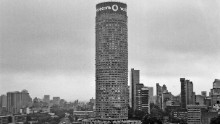
Photos: Johannesburg: City of skyscrapers
Boom and bust – Built
in 1976 at the height of developer confidence, the 173-meter Ponte City
Apartments building was designed for a young and affluent class of
owners.
But as the city declined during the 1980s, the tower was transformed into an urban slum that gained notoriety as a hub of prostitution, drug-dealing and violence.
But as the city declined during the 1980s, the tower was transformed into an urban slum that gained notoriety as a hub of prostitution, drug-dealing and violence.
Hide Caption
14 of 18
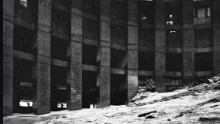
Photos: Johannesburg: City of skyscrapers
Out of sight – The
building was designed with a hollow core, into which residents
discarded their trash. At one point, the garbage pile role to 14 stories
high.
After discussions to convert the building into a prison were abandoned, the city redeveloped it as a block of expensive apartments, with 24-hour armed security.
After discussions to convert the building into a prison were abandoned, the city redeveloped it as a block of expensive apartments, with 24-hour armed security.
Hide Caption
15 of 18
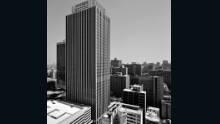
Photos: Johannesburg: City of skyscrapers
Survivor – The
Marble Towers have fared better since opening in 1973. The 32-floor
skyscraper serves as the headquarters of Sanlam insurance, and is also
referred to as the Sanlam Sentrum.
Hide Caption
16 of 18
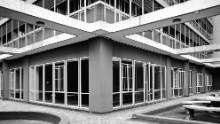
Photos: Johannesburg: City of skyscrapers
Inside view – Art-deco style courtyard of the Marble Towers.
Hide Caption
17 of 18

Photos: Johannesburg: City of skyscrapers
Island of stability – The
futuristic Standard Bank Centre, built from the top down in the heart
of Johannesburg's financial district, was hailed as a great
architectural achievement.
The 82-meter building opened in 1970 and remains occupied by the original tenants.
The 82-meter building opened in 1970 and remains occupied by the original tenants.
Hide Caption
18 of 18

Photos: Johannesburg: City of skyscrapers
Towering ambition – South
Africa's largest city is famous for a spectacular skyline, featuring
the two tallest buildings in Africa among a soaring range of
skyscrapers.
The recently released book Up Up: Stories of Johannesburg's Highrises charts the rise of the towers from a construction boom in the mid-20th century, through a sharp decline around the end of Apartheid, to the chaotic metropolis of today. The book draws on a mix of archive and contemporary photos, and accounts from resident 'Joburgers.'
The story displays the ambition of the city, also known colloquially as eGoli ("Place of gold" in Zulu), but also the dark corners where the dream unraveled.
The recently released book Up Up: Stories of Johannesburg's Highrises charts the rise of the towers from a construction boom in the mid-20th century, through a sharp decline around the end of Apartheid, to the chaotic metropolis of today. The book draws on a mix of archive and contemporary photos, and accounts from resident 'Joburgers.'
The story displays the ambition of the city, also known colloquially as eGoli ("Place of gold" in Zulu), but also the dark corners where the dream unraveled.
Hide Caption
1 of 18
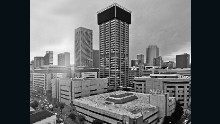
Photos: Johannesburg: City of skyscrapers
High Finance – The 140-meter Absa Tower in downtown Johannesburg opened in 1970, when it was the second tallest building in the city.
Absa Bank was later incorporated into Barclays Africa, which still uses the building as its headquarters.
Absa Bank was later incorporated into Barclays Africa, which still uses the building as its headquarters.
Hide Caption
2 of 18
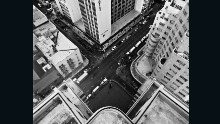
Photos: Johannesburg: City of skyscrapers
Don't look down – View from the Anstey's department store on the corner of Joubert and Jeppe streets.
The 20-floor building, which dates back to 1937, is the third store constructed by former mayor Norman Anstey's company, and the second is directly opposite.
The 20-floor building, which dates back to 1937, is the third store constructed by former mayor Norman Anstey's company, and the second is directly opposite.
Hide Caption
3 of 18
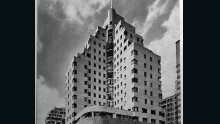
Photos: Johannesburg: City of skyscrapers
State of the art – Anstey's
is renowned as one of the most striking examples of the art deco style
of the time, built in the tradition of raised, curved ziggurats that
originated in ancient Mesopotamia.
Hide Caption
4 of 18
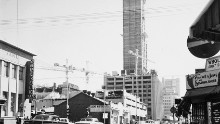
Photos: Johannesburg: City of skyscrapers
Brave new world – Construction
of the Carlton Centre in 1973, on the site of the Carlton Hotel. The
Centre was, and remains, the tallest skyscraper in Africa at 223 meters,
and represented an ambitious step forward for the city.
Hide Caption
5 of 18
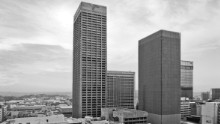
Photos: Johannesburg: City of skyscrapers
Birds eye view – The
50-storey colossus includes shopping malls and offices for companies
such as transport group Transnet, although it has struggled to maintain
occupancy rates.
The center is also a popular tourist attraction, offering unrivaled views of the city.
The center is also a popular tourist attraction, offering unrivaled views of the city.
Hide Caption
6 of 18

Photos: Johannesburg: City of skyscrapers
Party over – The
Carlton Hotel continued to operate within the Centre until it closed in
1998, having previously been a favorite of the rich and powerful, with
guests including Hillary Clinton, Whitney Houston and Mick Jagger.
The once-thriving hotel is now abandoned and gathering dust, including the extravagant indoor pool (above).
The once-thriving hotel is now abandoned and gathering dust, including the extravagant indoor pool (above).
Hide Caption
7 of 18
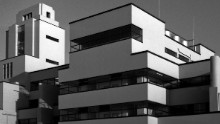
Photos: Johannesburg: City of skyscrapers
Chrysler house – One of the earliest and grandest of Johannesburg skyscrapers. The car showroom, built in 1938, occupies an entire city block.
The building is now being converted into housing and developers promise some of the lowest cost rental accommodation in the city.
The building is now being converted into housing and developers promise some of the lowest cost rental accommodation in the city.
Hide Caption
8 of 18

Photos: Johannesburg: City of skyscrapers
Night and day – The
12-storey Diplomat Hotel had a reputation as a glamor spot during the
1970s, but is now better known as a hub of the vice industry, sometimes
referred to as the 'House of the Rising Sun' of Johannesburg.
Hide Caption
9 of 18

Photos: Johannesburg: City of skyscrapers
Trail blazer – The
60-meter Eskom Centre was the tallest skyscraper in the city when it
was completed in 1955 as the headquarters of the Electricity Supply
Commission.
The building still stands today but the company moved out over 20 years ago, declaring it inadequate for modern business needs.
The building still stands today but the company moved out over 20 years ago, declaring it inadequate for modern business needs.
Hide Caption
10 of 18

Photos: Johannesburg: City of skyscrapers
Falling down – The
Hillpoint Highbrow was one of the most ambitious developments, standing
over 100-meters tall, and providing stylish accommodation for the city
elite on top of a popular cinema.
The towers later fell into dilapidation as the surrounding area declined, and continues to suffer with high rates of crime and poverty.
The towers later fell into dilapidation as the surrounding area declined, and continues to suffer with high rates of crime and poverty.
Hide Caption
11 of 18

Photos: Johannesburg: City of skyscrapers
Sunset – The
twin towers of the Johannesburg Sun Hotel sustained a five-star rating
from their opening in 1970 until the 1990s, when it was downgraded due
to high crime rates in the surrounding downtown area.
The hotel closed its doors in 1998, and after several failed attempts at reopening, stands empty today.
The hotel closed its doors in 1998, and after several failed attempts at reopening, stands empty today.
Hide Caption
12 of 18

Photos: Johannesburg: City of skyscrapers
Nobody home – Foyer of the Sun hotel after its abandonment.
There are plans to revive the site, although this will require massive investment at high risk.
There are plans to revive the site, although this will require massive investment at high risk.
Hide Caption
13 of 18

Photos: Johannesburg: City of skyscrapers
Boom and bust – Built
in 1976 at the height of developer confidence, the 173-meter Ponte City
Apartments building was designed for a young and affluent class of
owners.
But as the city declined during the 1980s, the tower was transformed into an urban slum that gained notoriety as a hub of prostitution, drug-dealing and violence.
But as the city declined during the 1980s, the tower was transformed into an urban slum that gained notoriety as a hub of prostitution, drug-dealing and violence.
Hide Caption
14 of 18

Photos: Johannesburg: City of skyscrapers
Out of sight – The
building was designed with a hollow core, into which residents
discarded their trash. At one point, the garbage pile role to 14 stories
high.
After discussions to convert the building into a prison were abandoned, the city redeveloped it as a block of expensive apartments, with 24-hour armed security.
After discussions to convert the building into a prison were abandoned, the city redeveloped it as a block of expensive apartments, with 24-hour armed security.
Hide Caption
15 of 18

Photos: Johannesburg: City of skyscrapers
Survivor – The
Marble Towers have fared better since opening in 1973. The 32-floor
skyscraper serves as the headquarters of Sanlam insurance, and is also
referred to as the Sanlam Sentrum.
Hide Caption
16 of 18

Photos: Johannesburg: City of skyscrapers
Inside view – Art-deco style courtyard of the Marble Towers.
Hide Caption
17 of 18

Photos: Johannesburg: City of skyscrapers
Island of stability – The
futuristic Standard Bank Centre, built from the top down in the heart
of Johannesburg's financial district, was hailed as a great
architectural achievement.
The 82-meter building opened in 1970 and remains occupied by the original tenants.
The 82-meter building opened in 1970 and remains occupied by the original tenants.
Hide Caption
18 of 18

Photos: Johannesburg: City of skyscrapers
Towering ambition – South
Africa's largest city is famous for a spectacular skyline, featuring
the two tallest buildings in Africa among a soaring range of
skyscrapers.
The recently released book Up Up: Stories of Johannesburg's Highrises charts the rise of the towers from a construction boom in the mid-20th century, through a sharp decline around the end of Apartheid, to the chaotic metropolis of today. The book draws on a mix of archive and contemporary photos, and accounts from resident 'Joburgers.'
The story displays the ambition of the city, also known colloquially as eGoli ("Place of gold" in Zulu), but also the dark corners where the dream unraveled.
The recently released book Up Up: Stories of Johannesburg's Highrises charts the rise of the towers from a construction boom in the mid-20th century, through a sharp decline around the end of Apartheid, to the chaotic metropolis of today. The book draws on a mix of archive and contemporary photos, and accounts from resident 'Joburgers.'
The story displays the ambition of the city, also known colloquially as eGoli ("Place of gold" in Zulu), but also the dark corners where the dream unraveled.
Hide Caption
1 of 18

Photos: Johannesburg: City of skyscrapers
High Finance – The 140-meter Absa Tower in downtown Johannesburg opened in 1970, when it was the second tallest building in the city.
Absa Bank was later incorporated into Barclays Africa, which still uses the building as its headquarters.
Absa Bank was later incorporated into Barclays Africa, which still uses the building as its headquarters.
Hide Caption
2 of 18

Photos: Johannesburg: City of skyscrapers
Don't look down – View from the Anstey's department store on the corner of Joubert and Jeppe streets.
The 20-floor building, which dates back to 1937, is the third store constructed by former mayor Norman Anstey's company, and the second is directly opposite.
The 20-floor building, which dates back to 1937, is the third store constructed by former mayor Norman Anstey's company, and the second is directly opposite.
Hide Caption
3 of 18

Photos: Johannesburg: City of skyscrapers
State of the art – Anstey's
is renowned as one of the most striking examples of the art deco style
of the time, built in the tradition of raised, curved ziggurats that
originated in ancient Mesopotamia.
Hide Caption
4 of 18

Photos: Johannesburg: City of skyscrapers
Brave new world – Construction
of the Carlton Centre in 1973, on the site of the Carlton Hotel. The
Centre was, and remains, the tallest skyscraper in Africa at 223 meters,
and represented an ambitious step forward for the city.
Hide Caption
5 of 18

Photos: Johannesburg: City of skyscrapers
Birds eye view – The
50-storey colossus includes shopping malls and offices for companies
such as transport group Transnet, although it has struggled to maintain
occupancy rates.
The center is also a popular tourist attraction, offering unrivaled views of the city.
The center is also a popular tourist attraction, offering unrivaled views of the city.
Hide Caption
6 of 18

Photos: Johannesburg: City of skyscrapers
Party over – The
Carlton Hotel continued to operate within the Centre until it closed in
1998, having previously been a favorite of the rich and powerful, with
guests including Hillary Clinton, Whitney Houston and Mick Jagger.
The once-thriving hotel is now abandoned and gathering dust, including the extravagant indoor pool (above).
The once-thriving hotel is now abandoned and gathering dust, including the extravagant indoor pool (above).
Hide Caption
7 of 18

Photos: Johannesburg: City of skyscrapers
Chrysler house – One of the earliest and grandest of Johannesburg skyscrapers. The car showroom, built in 1938, occupies an entire city block.
The building is now being converted into housing and developers promise some of the lowest cost rental accommodation in the city.
The building is now being converted into housing and developers promise some of the lowest cost rental accommodation in the city.
Hide Caption
8 of 18

Photos: Johannesburg: City of skyscrapers
Night and day – The
12-storey Diplomat Hotel had a reputation as a glamor spot during the
1970s, but is now better known as a hub of the vice industry, sometimes
referred to as the 'House of the Rising Sun' of Johannesburg.
Hide Caption
9 of 18

Photos: Johannesburg: City of skyscrapers
Trail blazer – The
60-meter Eskom Centre was the tallest skyscraper in the city when it
was completed in 1955 as the headquarters of the Electricity Supply
Commission.
The building still stands today but the company moved out over 20 years ago, declaring it inadequate for modern business needs.
The building still stands today but the company moved out over 20 years ago, declaring it inadequate for modern business needs.
Hide Caption
10 of 18



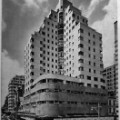
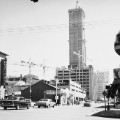
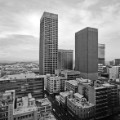
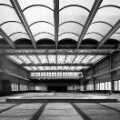
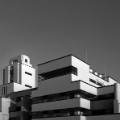

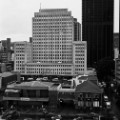
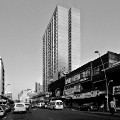
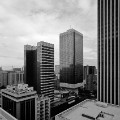
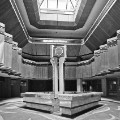
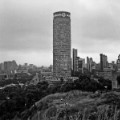
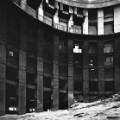

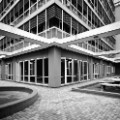
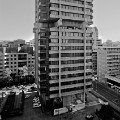
South
Africa's largest city is famous for a spectacular skyline, featuring
the two tallest buildings in Africa among a soaring range of
skyscrapers.




0 Comments